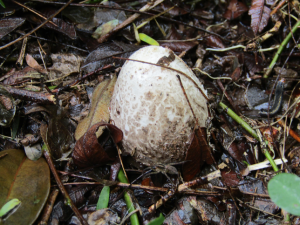
With the heavy rains in July, we have had lots of wild mushrooms popping up on the farm. The Stinkhorn otherwise known as bamboo pith or bamboo fungus (Phallus indusiatus) has been a common one for us. These are edible and we are perfectly happy to eat them. I say this because I have seen strange looks from Non-Asian people who look too frightened to try this epicurean delight.
These mushrooms start off as an egg-shaped structure, commonly known as “Witches’ Eggs.”

You can pick them at this stage to eat; once cooked, they have a gooey texture. They are alright (not great) if you are feeling adventurous…best pan-fried with onions and garlic.
Asian people eat the mushrooms at this stage when they become erect and rather phallic looking. In the Asian Market, they are cultivated and sold dehydrated.


You can stir-fry them and put them in stews and soups. Go on then…do something different today and find some of these lovely specimens in Toledo and cook them up for dinner!! They are supposed to be an aphrodisiac!




